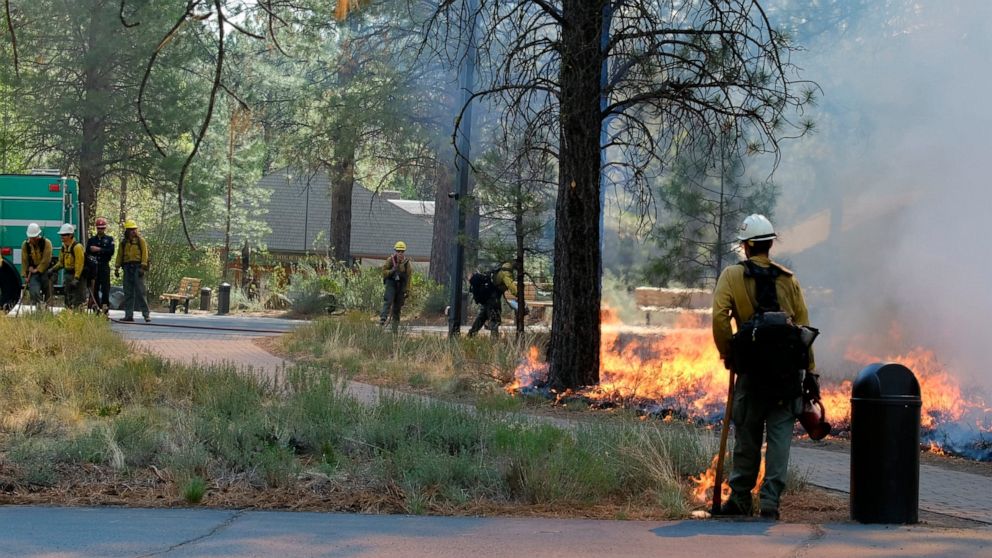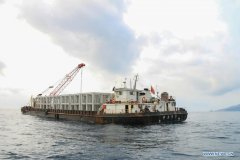'Nothing looks good' preparing for summer wildfire season
Crews across the U.S. West are lighting controlled burns and taking other steps to prepare for the 2021 fire season that follows the worst one on record
May 27, 2021, 8:44 PM
6 min read
Share to FacebookShare to TwitterEmail this article
1:14
Firefighters are scrambling to battle the blaze before it reaches a drought-plagued region.
The Associated PressSALEM, Ore. -- Wearing soot-smudged, fire-resistant clothing and helmets, several wildland firefighters armed with hoes moved through a stand of ponderosa pines as flames tore through the underbrush.
The firefighters weren’t there to extinguish the fire. They had started it.
The prescribed burn, ignited this month near the scenic mountain town of Bend, is part of a massive effort in wildlands across the U.S. West to prepare for a fire season that’s expected to be even worse than last year′s record-shattering one.
The U.S. Forest Service and the Bureau of Land Management have thinned by hand, machines and prescribed burns about 1.8 million acres (728,000 hectares) of forest and brushland since last season, officials from the agencies told The Associated Press. They typically treat some 3 million (1.2 million hectares) acres every year.
All that activity, though, has barely scratched the surface. The federal government owns roughly 640 million acres (260 million hectares) in the U.S. All but 4% of it lies in the West, including Alaska, with some of it unsuitable for prescribed burning.
“All these steps are in the right direction, but the challenge is big and complex,” said John Bailey, professor of silviculture and fire management at Oregon State University. “And more needs to be done to even turn the corner.”
The efforts face a convergence of bleak forces.
Severe drought has turned forests and grasslands into dry fuels, ready to ignite from a careless camper or a lightning strike. More people are building in areas bordering wildlands, expanding the so-called wildland-urban interface, an area where wildfires impact people the most. Invasive, highly flammable vegetation is spreading uncontrolled across the West.
“I’m seeing probably the worst combination of conditions in my lifetime,” said Derrick DeGroot, a county commissioner in southern Oregon’s Klamath County. “We have an enormous fuel load in the forests, and we are looking at a drought unlike we’ve seen probably in the last 115 years.”
Asked how worried he is about the 2021 fire season, DeGroot said: “On a scale of 1 to 10, I’m a 12. Nothing looks good.”
In other prevention measures in the West, utility companies are removing vegetation around power lines and are ready to impose blackouts when those lines threaten to spark a fire.
Armies of firefighters are being beefed up. And communities are offering incentives for residents to make their own properties fire-resistant.
Still, much work remains to change the region's trajectory with fire, particularly in two key areas, said Scott Stephens, professor of wildland fire science at the University of California, Berkeley.
“One is getting people better prepared for the inevitability of fire in areas like the wildland-urban interface. That includes new construction,” he said. "And the second is getting our ecosystems better prepared for climate change and fire impacts.”
On the local level, individuals and communities need to create defensible spaces and evacuation plans, he said. On the government level, more resources need to go toward managing forests.
“I think we’ve got one to two decades," Stephens said. "If we don’t do this in earnest, we’re frankly just going to be watching the forest change right in front of our eyes from fire, climate change, drought, insects, things of that nature.”
Part of the issue is that increasing wildfire resilience often requires trade-offs, said Erica Fleishman, professor at Oregon State University’s College of Earth, Ocean, and Atmospheric Sciences.
Cities or states could require defensible spaces around homes. Building codes could call for fire-resistant materials. That would drive up construction costs but also mean homes would be less likely to burn and need rebuilding, she said.
“The insurance industry and the building industry and communities and lawmakers are all going to need to have the will to create these changes,” she said.
Fleishman also believes more prescribed fires could be conducted in the wildland-urban interface, but said “society is risk averse.”
“Right now, there’s not, in many cases, a whole lot of will to do it,” she said.
Prescribed burns target vegetation that carries flames into forest canopies, where they can explode into massive wildfires.







